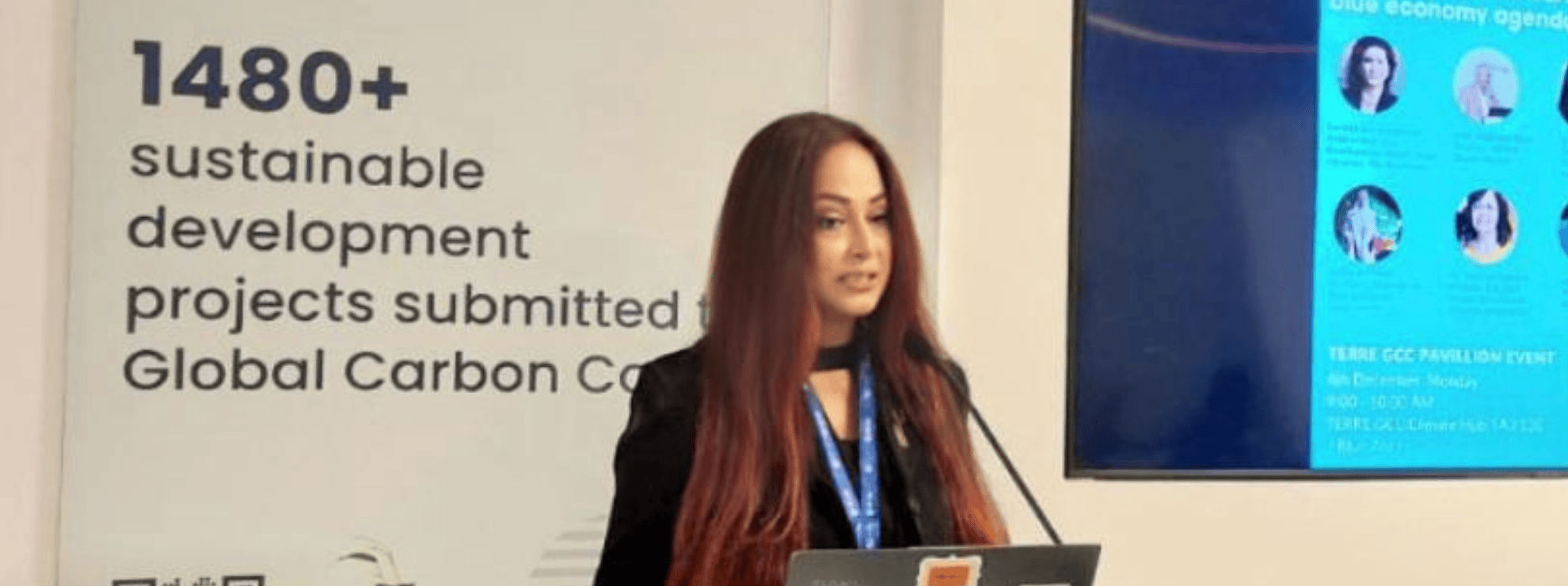(November 1, 2024) Elsie Gabriel is a prominent Indian environmentalist and climate change consultant, renowned for her extensive work in ocean literacy and sustainable development. As the founder of the Young Environmentalists Programme Trust, she has dedicated her life to educating youth and communities about the importance of environmental stewardship. Her initiatives have reached beyond Indian borders, gaining recognition on global platforms, including the United Nations Climate Change Conference and UNESCO’s Green Citizen-Ocean Literacy Project. With her advocacy, she has trained thousands of young people and community leaders worldwide, emphasizing the need for immediate action against climate change and the preservation of marine ecosystems. Elsie believes that local action can ripple into global impact, in a planet where everything is interconnected. Most recently, she was part of a cohort of leaders from the Women Climate Collective who were in attendance at the New York Climate Week, in collaboration with the Fondation L’oreal.
Elsie speaks to Global Indian from the Andamans, where she is engaged with training diving instructors in disaster management, and also teaching them to identify the impacts of climate change in the depths of the ocean. It’s an advanced programme, and not for the faint of heart. “We need divers to be informed of climate change – these are the people who know our waters best. If there is a tsunami, climate crisis or a flood, these divers will know how to handle their communities, and ensure that people with disabilities, senior citizens, children and women are made a priority in rescue efforts, since they tend to be the last to get saved,” Elsie explains.

Elsie Gabriel
A Flooded City Sparks a Lifelong Mission
In 2005, during one of Mumbai’s worst floods, Elsie Gabriel watched as her city was submerged. Families in hutments were trapped in murky waters, and for the first time, she understood the vast web connecting the planet’s ecosystems. This crisis fueled her spirit, galvanizing her to begin what would soon become a life mission — protecting the environment, one child, one city, and eventually, one ocean at a time.
The impact of that flood was visceral for Elsie, prompting her to transform her observations into action. Witnessing the devastation and the immediate need for intervention, she realized that simply distributing biscuits and blankets was inadequate. “It wasn’t about providing temporary relief,” she reflected. “It was about understanding the systemic issues and educating our communities.” Within a year, she founded the Young Environmentalists Programme Trust in Mumbai, designed to foster environmental education and grassroots change.
Her work was urgent, clear-eyed, and tireless. “We’re talking about interconnectedness,” she said, “from the naalas and lakes to rivers, sewers, and eventually, the oceans.” That early momentum was not just about environmental advocacy; it was about teaching the science behind the crisis, demonstrating how plastic pollution, coastal erosion, and climate change compound each other in ways that put communities directly in harm’s way. Through the trust, she began addressing these links head-on, turning environmental education into a tool for survival.
Building a Network of Changemakers
Elsie’s work soon propelled her from local initiatives to global circles. After completing her postgraduate education in Environmental Education and Island Development, she began to emerge as both an advocate and spokesperson for climate action. Her commitment to education and advocacy took her to Harvard University, where she participated in a leadership program for senior executives. This experience broadened her perspective and equipped her with the tools necessary to amplify her mission on a global scale.

In 2014 in Rio Brazil, Elsie was trained and certified as a climate Reality Leader by former Vice President of USA Al Gore and today she is the National Cordinator Oceans for Climate Reality Project India. “Working with Al Gore was transformative,” she noted. “He taught us how to translate complex climate science into actionable education.” This partnership opened doors to international platforms, including the UN Climate Change Conference, where she presented her initiatives and advocated for stronger climate policies.
Her efforts soon reached beyond Mumbai, taking her voice and mission to international forums where she amplified the call for ocean conservation and climate action. By leading the UNESCO Green Citizen-Ocean Literacy Project, she established collaborations with global organizations, facilitating knowledge exchange and grassroots initiatives worldwide. Elsie’s advocacy highlights the urgent need for collaboration across borders, showcasing the interconnectedness of climate issues that transcend local contexts.
Back home, however, she faced obstacles in shifting mindsets around plastic use and waste management. Many locals remained reliant on single-use plastics and resistant to new practices, making her work both challenging and transformative. Undeterred, Elsie organized community cleanups, took students on field trips, and initiated ocean literacy programs. “We don’t just preach,” she explained. “We engage, we dive, and we get our hands dirty because understanding our impact on oceans is fundamental to fighting climate change.”
From Diving to Defending: A Passion for the Ocean

Elsie has dived all over the world, and was inducted into the Women Divers Hall of Fame as an Associate Member in 2023
Elsie’s commitment to ocean conservation intensified through her experiences as a certified diver. Her dives, which have taken her from the Andaman Islands to the coral reefs of Australia, were not merely personal pursuits but essential to her understanding of marine ecosystems. “Without blue, there’s no green,” she often says, highlighting the critical role oceans play in the planet’s health. Diving became a way for Elsie to witness firsthand the damage inflicted by climate change, pollution, and plastics, strengthening her resolve to educate others on ocean literacy.
Her dive experiences not only deepened her passion but also provided her with unique insights that she could share globally. During her travels, she engaged with local communities, conducting workshops and training sessions on sustainable practices. “Every dive is a lesson,” she shared. “It’s about understanding the delicate balance of our ecosystems and the impact our actions have.” These interactions allowed her to build a network of advocates across the globe, each committed to fighting for the health of our oceans.
Empowering Women and Youth in Environmental Action
In addition to her ocean conservation work, Elsie Gabriel has made it her mission to empower women, youth, and marginalized groups in environmental action. Recognizing the need for diverse voices in climate advocacy, she has created initiatives specifically to train and support women in coastal areas and young people in schools. “Women are natural caretakers,” she said, explaining her drive to equip them with the tools to lead conservation efforts in their communities. Her work with these groups has become a cornerstone of her broader environmental impact, resonating in both local and international contexts.

Elsie’s focus on empowering women in particular has led to groundbreaking initiatives. Through workshops and training programs, she encourages women to take up roles as environmental leaders, emphasizing that their unique perspectives and experiences are invaluable in the fight against climate change. “We need all hands on deck,” she insists, believing that inclusivity strengthens the movement.
In fact, their programme is now part of 300 schools in Mumbai alone, and what started with a group of volunteers asking schools to let them use free periods, has now become an asset to the curriculum. “We started out taking over free periods – for instance, if that happened to be an English class, we would do newspaper writing and convert it into an article writing class where the topics correlated to the environment.” Students are taken on field trips to the nearby mangroves, and for cleanups in Pawai Lake and on the beach. Slowly, the children began building a connection with the earth, and also getting a much-needed digital detox.
A Vision for the Future
Elsie’s journey has taken her from flooded streets in Mumbai to the podiums of UN conferences, where she advocates for climate education and ocean conservation policies. Whether on international stages or in local communities, she calls for a shift in policy and curriculum to include climate literacy from a young age. Her book, Get Out, Get Going Outdoors, encourages young people to connect with nature, a value she believes essential to forming resilient, environmentally conscious future generations.
As her journey continues, Elsie remains steadfast in her mission to mainstream ocean literacy, reduce plastic pollution, and empower local communities. “We have to keep our planet intact for the next generation,” she insists. Her story, now spanning decades, speaks to the transformative impact one person can have, building waves of change that ripple across the globe.
With her eyes set on the future, Elsie is not just dreaming of a better world; she is actively working towards it. Her initiatives aim to inspire a generation of environmental stewards equipped to face the challenges posed by climate change. As she travels the world sharing her message, she continues to embody the essence of a true global citizen — committed, passionate, and unyielding in her pursuit of a sustainable future for all.







Amazing life journey!